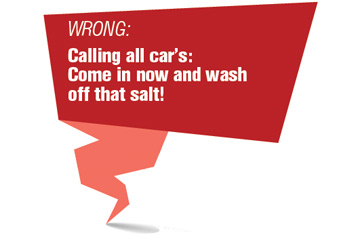As I drive to work every morning, I pass an electronic sign that reads “2 Large Pizza’s for $19.99.” As any other grammar sticklers out there would agree, this kind of misuse of the apostrophe drives me crazy. An apostrophe does not make a word plural; an apostrophe makes a word possessive or is used to create a contraction. As social media has created a more casual way of communicating, proper grammar, unfortunately, seems to have gone out the window. Whether you are running a new advertisement in a local paper, posting a status update on your business’ Facebook page or adding or changing a message on an electronic or standard sign on your property, your signs and your messages are a reflection on you and your business. You want them to be correct and accurate in addition to eye-catching. The last thing you would want to do is detract potential customers. Proofreading is a simple and important step to avoid errors.
So proofread your signs and promotions, and you’re going to thank me.
Here are the top mistakes I see on a daily basis.
- Use of apostrophes: As I mentioned above, apostrophes are not used to make words plural. Apostrophes are used to make a word possessive or are used to create a contraction (such as you’re and they’re).
- Your/ You’re: “Your” is possessive (“Wash your car often”) while “you’re” is a contraction for “you are.”
- They’re/ Their/ There: “They’re” is a contraction for “they are.” “Their” is possessive (“They took their car to the carwash”) while “there” is used in all other instances.
- It’s/ its: “It’s” is a contraction for “it is” or “it has.” “Its” is possessive (“The dog wagged its tail”).
- Than/Then: Use “than” in comparisons (“This car is faster than that car”). Use “then” when referring to a sequence of events (“Do this then do that”).
- Could’ve/Would’ve/Should’ve: Could’ve, would’ve and should’ve are all contractions for “could have,” “would have” and “should have,” respectively. Although all three contractions sound like they end in “of” when spoken, “could of,” “would of” and “should of” are incorrect.
7. Quiz: See if you can find all of the mistakes in the following sign (answer is on the next page):
Kelly Swope is the Marketing Programs Coordinator at Blendco Systems.Blendco Systems manufactures and supplies a full line of formulated detergents, polishes and protectants for the professional carwash industry, including the patented SuperSat® Custom Detergent System. Blendco has been providing innovative and environmentally sound detergent solutions for more than 30 years. Blendco is a division of DuBois Chemicals, a leader in sustainable cleaning solutions since 1920.














